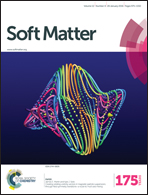Role of the active viscosity and self-propelling speed in channel flows of active polar liquid crystals
Abstract
We study channel flows of active polar liquid crystals (APLCs) focusing on the role played by the active viscosity (β) and the self-propelling speed (ω) on the formation and long time evolution of spontaneous flows using a continuum model. First, we study the onset of spontaneous flows by carrying out a linear stability analysis on two special steady states subject to various physical boundary conditions. We identify a single parameter b1, proportional to a linear combination of the active viscosity and the self-propelling speed, and inversely proportional to a Frank elastic constant, the solvent viscosity, and the liquid crystal relaxation time. We show that the active viscosity and the self-propelling speed influence the onset of spontaneous flows through b1 in that for any fixed value of the bulk activity parameter ζ, large enough |b1| can suppress the spontaneous flow. We then follow spontaneous flows in long time to further investigate the role of β and ω on spatial-temporal structures in the nonlinear regime numerically. The numerical study demonstrates a strong correlation between the most unstable eigenfunction obtained from the linear analysis and the terminal steady state or the persistent, traveling wave structure, revealing the genesis of flow and orientational structures in the active matter system. In the nonlinear regime, a nonzero b1 facilitates the formation of traveling waves in the case of boundary anchoring (the Dirichlet boundary condition) so long as the linear stability analysis predicts an onset of spontaneous flows; in the case of the free boundary condition (the Neumann boundary condition), a stable, spatially homogeneous tilted state always emerges in the presence of two active effects. Finally, we note that various fully out-of-plane spatio-temporal structures can emerge in long time dynamics depending on the boundary condition as well as the initial state of the polarity vector field.



 Please wait while we load your content...
Please wait while we load your content...